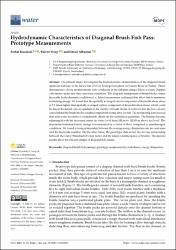| dc.contributor.author | Küçükali, Serhat | |
| dc.contributor.author | Verep, Bülent | |
| dc.contributor.author | Albayrak, İsmail | |
| dc.date.accessioned | 2023-08-31T11:02:18Z | |
| dc.date.available | 2023-08-31T11:02:18Z | |
| dc.date.issued | 2023 | en_US |
| dc.identifier.citation | Küçükali, S., Verep, B. & Albayrak, İ. (2023). Hydrodynamic Characteristics of Diagonal Brush Fish Pass: Prototype Measurements. Water, 15(1), 88. https://doi.org/10.3390/w15010088 | en_US |
| dc.identifier.issn | 2073-4441 | |
| dc.identifier.uri | https://doi.org/10.3390/w15010088 | |
| dc.identifier.uri | https://hdl.handle.net/11436/8210 | |
| dc.description.abstract | The present study investigates the hydrodynamic characteristics of the diagonal brush upstream fishway at the Incirli run-of-river hydropower plant on Iyidere River in Turkey. Three-dimensional velocity measurements were conducted in the fish pass using a Micro acoustic Doppler velocimeter under real-time operation conditions. The diagonal arrangement of brush blocks creates favorable hydrodynamic conditions (i.e., lateral momentum exchange) that allow fish to minimize swimming energy. We found that the spatially averaged lateral component of Reynolds shear stress is 2.2 times higher than spatially averaged vertical component of Reynolds shear stress, which could be due to the lateral velocity gradient in the vicinity of brush blocks. It is shown that the low-velocity zones behind the brush blocks constitute important resting sites for fish. The monitoring data showed that inlet water levels have considerable effects on the turbulence quantities. The brushes become submerged with the increased reservoir water level from 102 m to 102.05 m above sea level. The maximum turbulent kinetic energy was increased by a factor of three compared to unsubmerged conditions. We found a strong relationship between the average energy dissipation rate per unit mass and the Reynolds number. On the other hand, the prototype data reveal the inverse relationship between the Darcy-Weissbach friction factor and the relative submergence of bristles. The present results allow the efficient design of diagonal fish passes. | en_US |
| dc.language.iso | eng | en_US |
| dc.publisher | MDPI | en_US |
| dc.rights | info:eu-repo/semantics/openAccess | en_US |
| dc.subject | Diagonal brush fish passage | en_US |
| dc.subject | Prototype measurements | en_US |
| dc.subject | Turbulence | en_US |
| dc.subject | Energy dissipation | en_US |
| dc.title | Hydrodynamic characteristics of diagonal brush fish pass: prototype measurements | en_US |
| dc.type | article | en_US |
| dc.contributor.department | RTEÜ, Su Ürünleri Fakültesi, Su Ürünleri Temel Bilimler Bölümü | en_US |
| dc.contributor.institutionauthor | Verep, Bülent | |
| dc.identifier.doi | 10.3390/w15010088 | en_US |
| dc.identifier.volume | 15 | en_US |
| dc.identifier.issue | 1 | en_US |
| dc.identifier.startpage | 88 | en_US |
| dc.relation.journal | Water | en_US |
| dc.relation.publicationcategory | Makale - Uluslararası Hakemli Dergi - Kurum Öğretim Elemanı | en_US |


















